The inevitable came. The Saints were not in Nauvoo long before they all too well realized that this stay was not to be for long. It is very probable that many of these persecuted people hoped against hope, that Nauvoo would be their last move, for they were at the frontier's edge. However, their leaders who had kept abreast of the Lord's plans knew Nauvoo was not to be the end. The Lord had revealed that the mountains, far in the West, was to eventually become their home, however, the trip was to be sooner than most had anticipated.
Not a hint nor incident has been left by the Daniel D. Hunt family as to when they crossed the Mississippi for the West, nor do we know their circumstances. We know they remained there until after the temple had to be closed. We suspect they were not among the more affluent of the approximately twenty thousand people of the community, which made it the more difficult to equip themselves for traveling.
To visualize what was yet ahead took a prophet. Knowing there were twenty thousand people in Nauvoo, the most of us would have visualized preparations would have to be made for that number to cross the plains and eventually reach Salt Lake. Brigham Young didn't see the task before him to be that simple. He envisioned there were many times that number, at the moment, were leaving their homes, or preparing to leave their homes, some from as far away as Europe. These people hadn't yet reached Nauvoo, and he realized that the twenty thousand would be multiplied over and over again, within a few years' time. He realized there would be a steady stream of people - men, women and children, with all degrees of capabilities, or lack of capabilities. Most of them being the poor from the industrial cities of Europe, England in particular. England was where the bastion of Ephraim had gathered through the centuries, and unknowingly remained for this very opportunity to gather to Zion. The Lord's plans were being unfolded and only the inspired few realized it.
Brigham Young realized that this long trail of traveling human beings had to have assistance. Man's nature is that he can endure only so much before he has to have food to sustain him, and fabrics to clothe him, and that he or she was very limited as to the amount of either that could be brought with them. In his wisdom, he planned that supply stations be set up every hundred or two hundred miles. At these supply points, by assignment, families would stop on their journey, perhaps for a year or two at a time. There, they would erect shelters and plant crops for those yet behind them, who could harvest, not only for themselves, but also others. Then they would replant with rotation of turns at such stations.
Garden Grove, approximately half way across Iowa, and approximately 150 miles from Nauvoo was such a station. The Hunt family was invited to stay at the settlement. Several houses had already been erected, and hundreds of acres were being prepared, some already in crops. Undoubtedly, some fencing had to be done. We have no way of knowing how many families had been assigned to remain here, but there was a community of people all dedicated to not only assist themselves, but to assist others who were traveling through to the next station. There they could again restock with whatever supplies were needed. Also, blacksmith shops were built, and were in operation to give assistance to those who were having wagon problems, or who saw the need for strengthening their outfits, which had brought them this far. Perhaps there were some of the travelers who were sick and in need. Perhaps there were those that felt the need to stop over for the rest, both the humans and their animals.
We are not fully aware of the time the Hunt family left Nauvoo, but it appears it very well could have been the latter part of 1846. In chapter five a copy of a tithing receipt was shown, which is dated 12th of April of that year in Nauvoo. There was an organized branch of the Church at Garden Grove and we have evidence that Daniel D. was a member of the branch presidency as early as July of 1847, holding the position of first counselor. That presidency had an interesting experience.
Those of you who were in the Gospel doctrine class in 1950, may have noticed a quotation from the Journal History of the church relating to the dependent branch of Garden Grove. It was dependent to the branch of the Church at winter Quarters, still further west by half the length of the state of Iowa. By assignment of the First Presidency, Orson Hyde, a member of the Quorum of the Twelve, was to have responsibility of all Church units in the Iowa area. By virtue of his position, Orson Hyde wrote two letters, which will tell the story. These letters were written to the Garden Grove branch presidency, David Fullmer, Daniel D. Hunt, and Lyman A. Shirtleff, addressed specifically to David Fullmer.
"Dear Sir: The High Council here did yesterday withdraw the hand of fellowship from the branch of the Church at Garden Grove. Until a proper investigation can be had as to the real causes of the division and contentions that appear to exist in that branch. It is admitted by those who have lately come from that place, almost universally, that much theft and wickedness have existed there, and do still exist, and that the evil has overcome the good, and been suffered to get the preeminence and to disarm the good of all power to act. This is truly a lamentable state of things, and the Church and Council here were unwilling to receive into fellowship those who are coming from Garden Grove and thus become subjects of all the consequences that might arrive from the evils and crimes that have been suffered in your place. Those whose hands are clean and whose hearts are pure have no reason to fear although they of necessity have been disfellowshipped for the present..
"The above action of the Council upon your branch has been confirmed by the vote of the people here." (Journal History., July 18, 1847).
The officials of the Garden Grove branch were invited to a hearing which was held in Winter Quarters (approx. 125 miles away) presided over by the officials there on the 4th of August. A few days following the hearing, the Garden Grove branch presidency received the following letter:
"To the Church of Jesus Christ of Latter-day Saints,
"Greetings: Whereas the High Council in Winter Quarters, Indian Territory, in consequence of the representations being made to them, did on the 25th of July last, withdraw the hand of fellowship from that branch of the Church who reside in Garden Grove, Iowa Territory, now, therefore, this is to inform and witness unto the Church in all the world that on the 4th of August, inst., the presidency of Garden Grove branch, viz.: David Fullmer, Daniel D. Hunt, Lyman A. Shirtleff and Duncan McArthur, did appear before said Council in Winter Quarters, at which time the supposed existing difficulties were more fully examined and investigated by said Council, on which it appeared and was manifest that misrepresentations had been made derogatory to said branch by evil and designing persons and were without foundation in truth, therefore, the said High Council restored said branch at Garden Grove to full fellowship in all respects as they were when first organized." (Journal History, Aug. 7, 1847)
The Sunday School lesson manual mentioned as the source of the above information was for the year 1950, pages 66 and 67.
And so, Daniel D. Hunt, with the others of the branch presidency were exonerated of any wrong doing. What damage by evil tongues!
According to the membership records of the Garden Grove branch, the following of the Hunt family are listed: membership for 1847.
Daniel D. Hunt; Susan Hunt, wife; John A. Hunt, son; James W. Hunt, son; Levi Hunt, son; and Benoni Hunt, son.
The above were all over eight years of age and were baptized members of the church. No mention is made of the younger children on the records, but it can be expected that Daniel, who was then seven years of age, and Nancy, age five, would have been with the family. Oldest daughter, Susan Jane, did not appear to be with the family. She would have been nearly nineteen at the time, and very likely would have been married. She became a polygamist wife of John W. Cooley. If not married, she probably would have been employed elsewhere.
In accordance with the nature and purpose of the Garden Grove branch, it could not be expected that the Hunt family would remain there long. As is our usual story, we do not know when they moved on from their stay during most of 1847, but from a tax receipt made out on 29th of May 1849, we learn that he was in Kanesville during part, if not all of 1848. Kanesville in Pottawatomie County in Iowa, was another point selected by the Church for the emigrants to stop at the conclusion of another leg of their journey west. There again, crops were to either be harvested from the labors of those who went before, or to be planted so others coming after them would be able to harvest. Also, Kanesville was not only a food-producing area, but was considered more or less the "jumping off place" for the next thousand mile journey across Nebraska and Wyoming on the way to Salt Lake City. Outfitting wagon trains and handcart companies was a thriving business here on the banks of the Missouri River, and for a few years, Kanesville became a little metropolis of mainly Mormons. However, we must keep in mind there were others heading for California and the Oregon Territory who shared in these facilities.
 Receipt showing Great- grandfather D. D. Hunt paid ninety-two cents in full
for his taxes for 1848. Dated in Kanesville, Iowa 29 May 1849.
Receipt showing Great- grandfather D. D. Hunt paid ninety-two cents in full
for his taxes for 1848. Dated in Kanesville, Iowa 29 May 1849.
Tax receipts, in this instance, are proving that the Hunt family resided in Pottawatamie County through most, if not all, of 1848, and now, our next year's receipt assures us they there throughout the year of 1849. Undoubtedly, there was work, for by the end of 1849, the gold fever was in full bloom due to the discovery of gold in California the year previous. The Mormons who did not become affected by a desire to rush off to California, benefited considerably by the extra business there was for them.
Note that the next tax receipt was not made out until the end of January of 1850, so we are assured the Hunt family was yet in Iowa.
 Tax receipt to Great-grandfather D. D. Hunt showing he paid $1.20. Dated 30
January 1850 in Pottawatomie County, Iowa.
Tax receipt to Great-grandfather D. D. Hunt showing he paid $1.20. Dated 30
January 1850 in Pottawatomie County, Iowa.
1850 was the year the Hunt family crossed the plains to Utah. Of this there is no question, but it has become a disappointment that, to this day, we have failed to find any report or written account of their trip. If the reader will remember, we failed to find a record of the William Wilkes family, and now with the Hunt family, we are failing to learn the migration story of them. It seems hardly possible that we miss two separate families in a row, for the Church has preserved the record of most wagon trains, sailing vessels, and lastly, handcart companies. Undoubtedly, someday these records will be found, and very probably, they will be discovered in someone's home, who are not aware the records are being sought for by others of us.
Click here to read information and a time-line not available when Loyn Blacker wrote this accountIt seems that it would be safe to say that the history of Mormon Migration to Utah, will show that it required approximately three months to make the trip regardless of wagon train or handcart. There was variation - some taking a little less time than others - but the dry months of summer proved the more popular in which to commence the journey. June and July proved the more popular months, with June being more so than July. This made September the more popular for arrivals in Salt Lake, particularly the latter third of the month. Out of the approximately one hundred ninety-two wagon and handcart companies making the journey between 1847 and 1868, only two started as early as April, one of which was the first. In all, there were ten handcart companies. With the railroad reaching Utah in 1869, the era of wagon trains came to an end. As the railroad neared Utah, year by year, it shortened the distance of the wagon trains until by the time of the last year, 1868, the starting point for the wagon trains was as far west as Laramie and Benton, Wyoming. That was less than half the distance of the earlier trips.
A fact we might keep in mind relative to the dilemma of not finding the Wilkes nor Hunt families in the Church-sponsored wagon trains where they have not been located, is the fact that there were what was known as independent companies. Some of those included Mormon families, but were not directly handled by the Church. Just a possibility.
We have definite evidence that Daniel D. Hunt was in Salt Lake City on the 13th of September 1850, which leads us to generalize in which Church-sponsored wagon train they could have come in. The first wagon train of that year, left Kanesville, Iowa on June 3rd and arrived in Salt Lake August 30th. The second train left June 7th and arrived in Salt Lake on the 9th of September, and the third left June 12th and arrived on September 12th. The next wagon train did not arrive until September 20th, which was later than the 13th, which date we know he was in Salt Lake.
The evidence at hand is the following receipt Daniel D. received upon his paying Orson Hyde $50, which money was to be delivered by Orson Hyde to one Curtis Black of Pottawatomie County, Iowa.
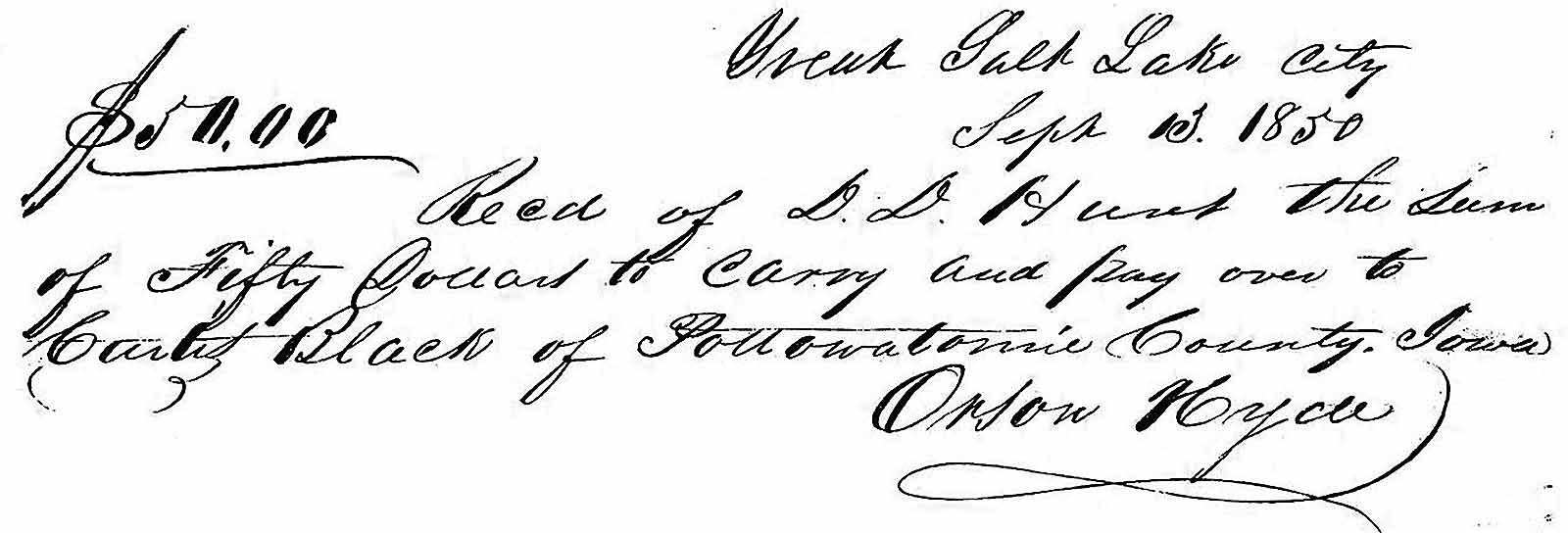 Receipt dated Sept. 13, 1850 at Great Salt Lake City, showing Great-grandfather
Daniel D. Hunt repaid $50.00, which was given Curtis Black of Pottawatomie Co.,
Iowa. This may be payment for a possible loan for D. D. Hunt to immigrate to
Utah. Note signature of Orson Hyde.
Receipt dated Sept. 13, 1850 at Great Salt Lake City, showing Great-grandfather
Daniel D. Hunt repaid $50.00, which was given Curtis Black of Pottawatomie Co.,
Iowa. This may be payment for a possible loan for D. D. Hunt to immigrate to
Utah. Note signature of Orson Hyde.
Orson Hyde's Quorum of the Twelve assignment during these years was to preside over the Church in the Iowa area, as has already been related. It appears from the above receipt that he had been in Utah and was ready to return to Iowa for a season. Could it have been that Curtis Black sponsored a loaning agency back in Kanesville, and that our Daniel D. had partially financed his trip west on borrowed money and that he was making his first payment in return? There is broad room here for speculation, which we will let each reader do for himself. The fact of importance here, is that Daniel D. and family were in Salt Lake by 13th of September 1850.
As we take our next step in following the Hunt family, we locate them in the 1850 Census of Utah, with a surprise. Actually, the title, "1850 Census of Utah" is a misnomer - or misapplied name - for the actual census was not taken until the spring of 1851. It would appear that this very first federal census of Utah was delayed for one of many possible reasons, but from then on, Utah got in stride with the regular federal census taken every ten years of each decade.
This census revealed the following:
| 1850 Census - - - Davis County | |||
| Name | Age | Occupation | Born |
| Daniel D. Hunt | 54 | Carpenter | N. Carolina |
| Martha " | 21 | Wales | |
| John A. " | 20 | N. C. | |
| James W. " | 18 | " | |
| Levi B. " | 15 | " | |
| Benoni " | 14 | " | |
| Daniel " | 10 | " | |
| Nancy " | 8 | " | |
This record became very revealing. First of all, Daniel's age confirms his claim of being born in 1797 rather than in 1800, both of which dates he has made in his personal record.
Next: This is the first time we have been made aware that his wife of Nauvoo
and Garden Grove is no longer with him. His personal record, a copy of which
is in the brown notebook to which reference has previously been given, does
not mention what happened to either of the sister-wives, Nancy and Susan Davis.Daniel D. Hunt had three wives. He married Nancy Davis in 1826 in Smith County, Tennessee. They had seven children. We have not found any record of her in Nauvoo, so she may have died before he moved there. On 19 January 1846 in Nauvoo Daniel was sealed to Nancy's younger sister, Susan, so she must have come with him from Tennessee.
On 8 June 1850 Daniel, Susan and his children left Nauvoo for Utah. Traveling with them was Martha Eynon from Wales. Susan died on the way. He was married Martha sometime after Susan died. We don't know when or where the marriage took place.
In the latter record, Daniel D. lists (but not particularly as his wife) "Martha
Hunt, a daughter of James and Elizabeth Eynon, born Sept. 10th A. D. 1829 in
Pembrokeshire, South Wales". Our previous family genealogical research had
revealed as much with her becoming the third wife of Daniel D. Hunt.
We have never discovered the details of this marriage. Where and when, have remained a mystery. That it occurred is factual, but we are left to speculate. Despite the fact that Daniel D. left bits of information, such as has been uncovered relative to what he and his family were doing, the final result is that he has been quite uncooperative so far as information about his wives - one at a time till now - is concerned. We complain, but don't intend to. Perhaps that which is essential is enough.
We invite the reader to study the above census record, and while we are on the subject of census, let us jump to the census ten years later at this point for purposes of easy comparison. We shall return to the other important data, which we are here passing over.
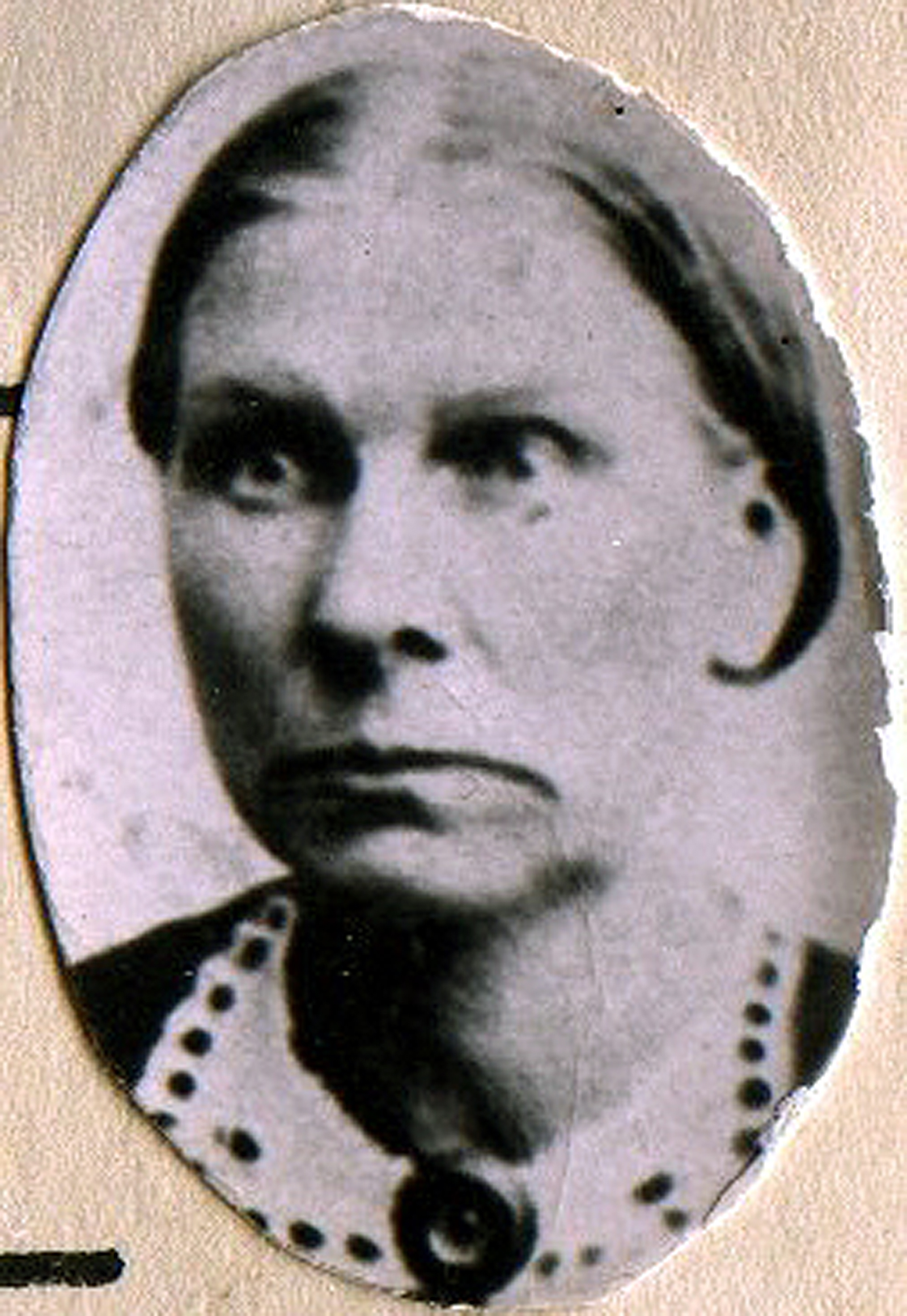 Martha Eynon Hunt
Martha Eynon Hunt
| 1860 Census - - - Salt Lake County | |||
| Name | Age | Occupation | Born |
| Daniel D. Hunt | 60 | Farmer | N. Carolina |
| Martha " | 33 | Wales | |
| Levi " | 25 | Farmer | Tenn |
| Benoni " | 23 | Farmer | " |
| Abel Moroni " | 7 | Salt Lake | |
| Gashum " | 5 | Lake City | |
| Martha E. " | 3 | Salt Lake | |
(Naturally, the census record did not pick it up, but Daniel D.'s and Martha's first-born, Mormon Brigham, born 25 Oct 1851, lived for only a few hours. He would have been nine years of age had he lived.)
As can be observed from an uncritical examination: Daniel D. now tells he was sixty, which will bring his birth year back to 1800. According to the census records, Martha lived twelve years during the nine-year period between the two censuses. Remember the 1850 census was actually taken in the spring of 1851. Sons Levi and Benoni, well into their twenties, were still at home, in fact they remained unmarried throughout their lives.
To the reader who is descended from John Wilkes and Martha Elizabeth Hunt, that little three year old of the 1860 census became our ancestor. She is our Martha Elizabeth Hunt Wilkes.
Attention was not called to the earlier of the two census records, that Daniel D., Martha and family were then (spring of 1851) living in Davis County, the county in which the Kaysville-Clearfield area is now in. Much transpired to them during the intervening years up until 1860, at which time they were then living in Salt Lake City.
A series of tithing confirmation slips for the year 1851 are of interest:
 Property tithing receipt shows it to have been paid in full to October 1851
in Great Salt Lake City. Receipt not dated until March 10, 1852
Property tithing receipt shows it to have been paid in full to October 1851
in Great Salt Lake City. Receipt not dated until March 10, 1852
 Produce" tithing paid in full for the year 1851
Produce" tithing paid in full for the year 1851
 Certificate presented to Great-grandfather Daniel D. Hunt, showing his labor
tithing was paid in full to Oct. 6, 1851 in Great Salt Lake City.
Certificate presented to Great-grandfather Daniel D. Hunt, showing his labor
tithing was paid in full to Oct. 6, 1851 in Great Salt Lake City.
Does the reader wonder about "labor" tithing and the nature of the labor? Nothing specific by way of description has come to light. We are aware that the temple had not been commenced in 1851, on which much donated labor was called for, however, there were many other community projects on which people were called to contribute time. School houses and church houses called for a lot of donated labor. Many early-day towns in Utah required forts to be built for protection from the Indians. The ten-foot high wall around Temple Square, was started in 1852, and required two years to build. Also a wall totaling a mile in length, was built around the University of Deseret on the east bench even before the Temple Square wall. In addition to donated labor, of course, the families had their own homes to prepare for their families. One can readily see there were few, if any, idlers in Zion.
 Receipt showing $7.60 paid in full for Great-grandfather's Utah State tax,
dated 6 December 1851 at Great Salt Lake City. Note that the receipt was signed
by William Clayton, writer of "Come, Come Ye Saints".
Receipt showing $7.60 paid in full for Great-grandfather's Utah State tax,
dated 6 December 1851 at Great Salt Lake City. Note that the receipt was signed
by William Clayton, writer of "Come, Come Ye Saints".
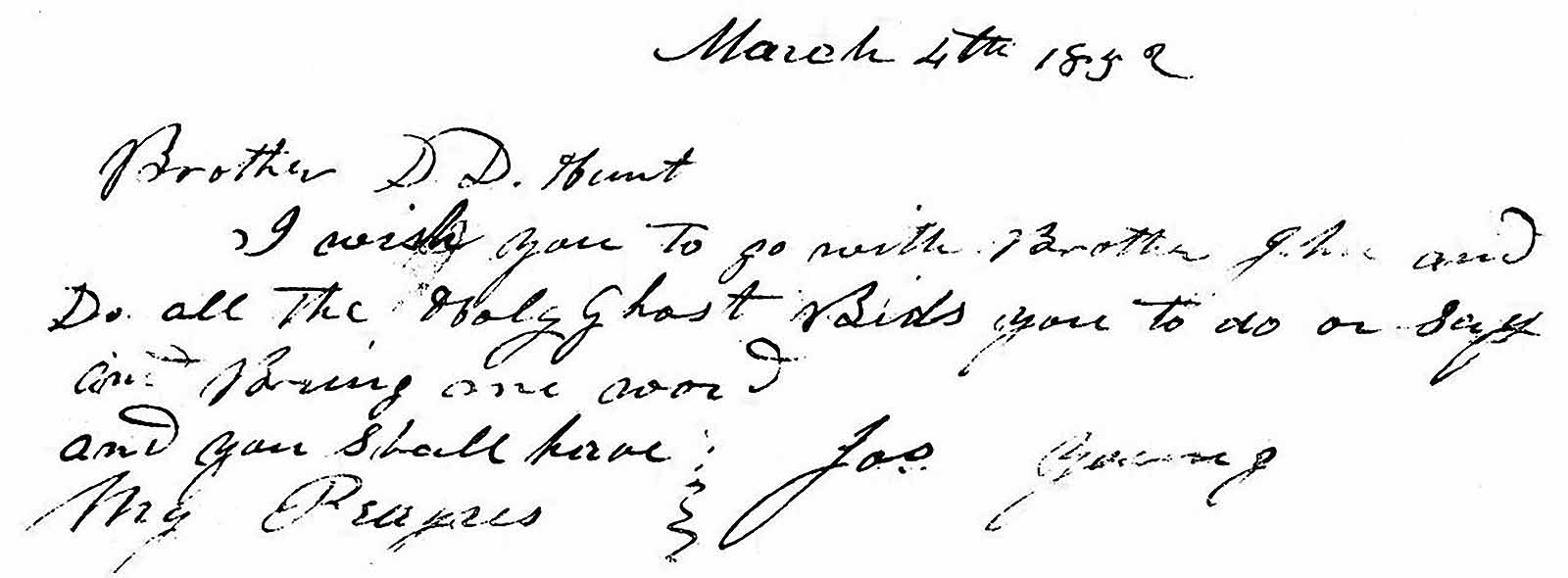 This note is self-explanatory. It was sent to Great-grandfather Daniel D. Hunt,
a Seventy, from one of his presiding brethren, Joseph Young, who was a member
of the Seven Presidents of the First Council of Seventy, therefore, a general
authority. The note is a local mission call.
This note is self-explanatory. It was sent to Great-grandfather Daniel D. Hunt,
a Seventy, from one of his presiding brethren, Joseph Young, who was a member
of the Seven Presidents of the First Council of Seventy, therefore, a general
authority. The note is a local mission call.
 Receipt indicating full payment of tithing to October 6, 1851. "With vote of
conference on Sept 10, 1851" is interesting, as also the delayed dating of
July 18, 1855.
Receipt indicating full payment of tithing to October 6, 1851. "With vote of
conference on Sept 10, 1851" is interesting, as also the delayed dating of
July 18, 1855.
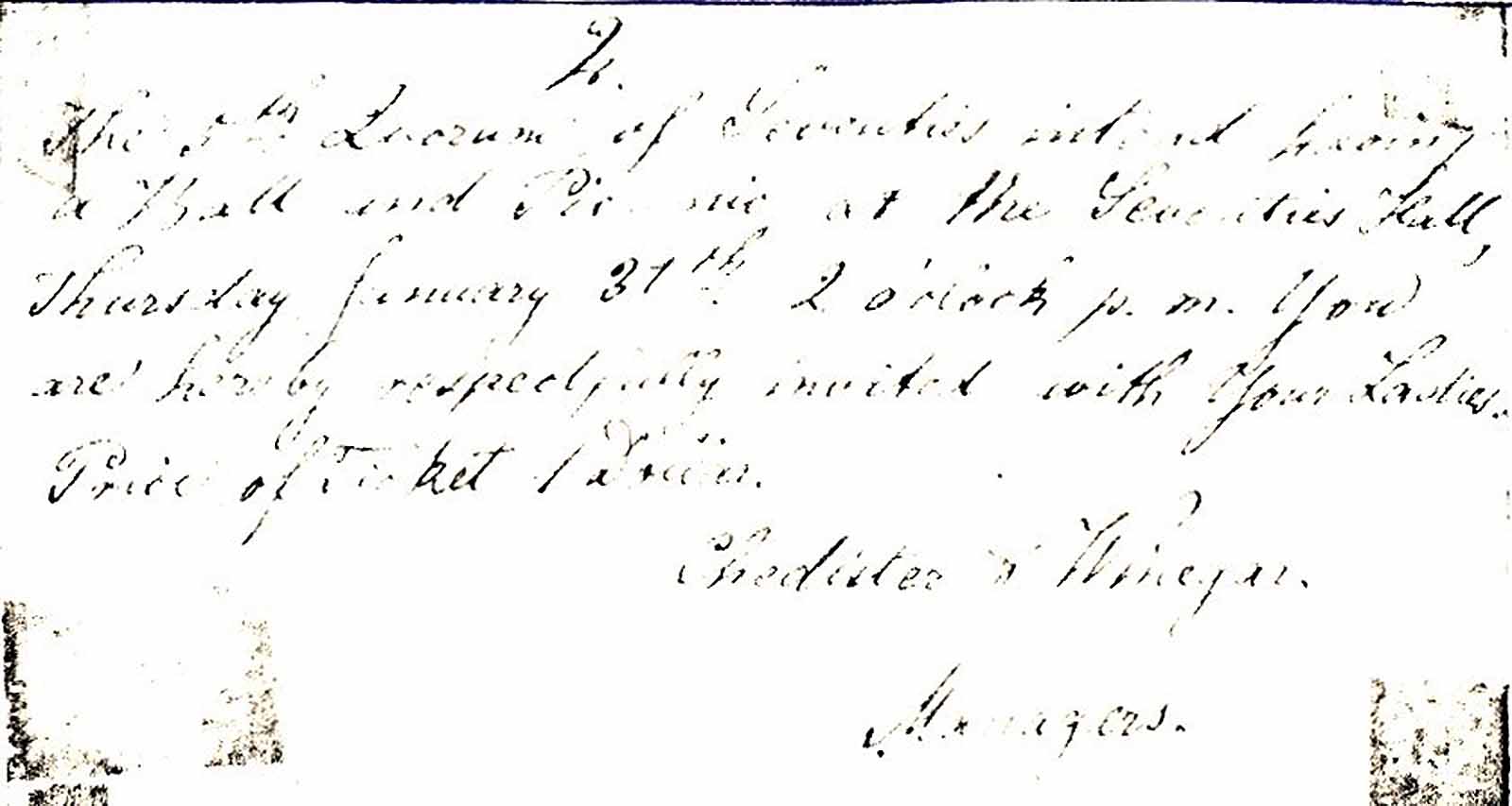
This is certainly an item of interest. It reads:
The 5th Quorum of Seventies intend having a Ball and Picnic at the Seventies
Hall. Thursday, January 31st, 2 o'clock p. m. You are hereby respectfully
invited with your Ladies. Price of ticket 1 Dollar
Managers
The year is not mentioned. Great-grandfather Daniel D. Hunt was president of the 5th quorum of Seventy. Social life was not over-looked.
It is of interest to us that for two or three years, Daniel D. and family remained in the Salt Lake City area, and became employed locally, probably carpentering, which it has been reported was his main trade. But with this, apparently, he beheld greener grass on "the other side of the fence".
It is possible that it was as early as the last of 1852, or certainly early in 1853, that the family made the move from the city of Salt Lake to a small town around the "point of the mountain" some twenty miles south of Salt Lake City, into Utah Valley. This town was then known as Lake City, which subsequently became American Fork. The Encyclopedic History of the Church, page 29, tells us that present-day American Fork was settled in the fall of 1850, and that it was incorporated as Lake City, on the 4th of June 1853, but the name was changed later to American Fork. A regular bishop's ward was organized there 25 May 1851.
It is of interest to note, as official notification shows below, Daniel D. was elected an alderman (member of the city or town council) on July 4th. 1853, just one month following its incorporation.
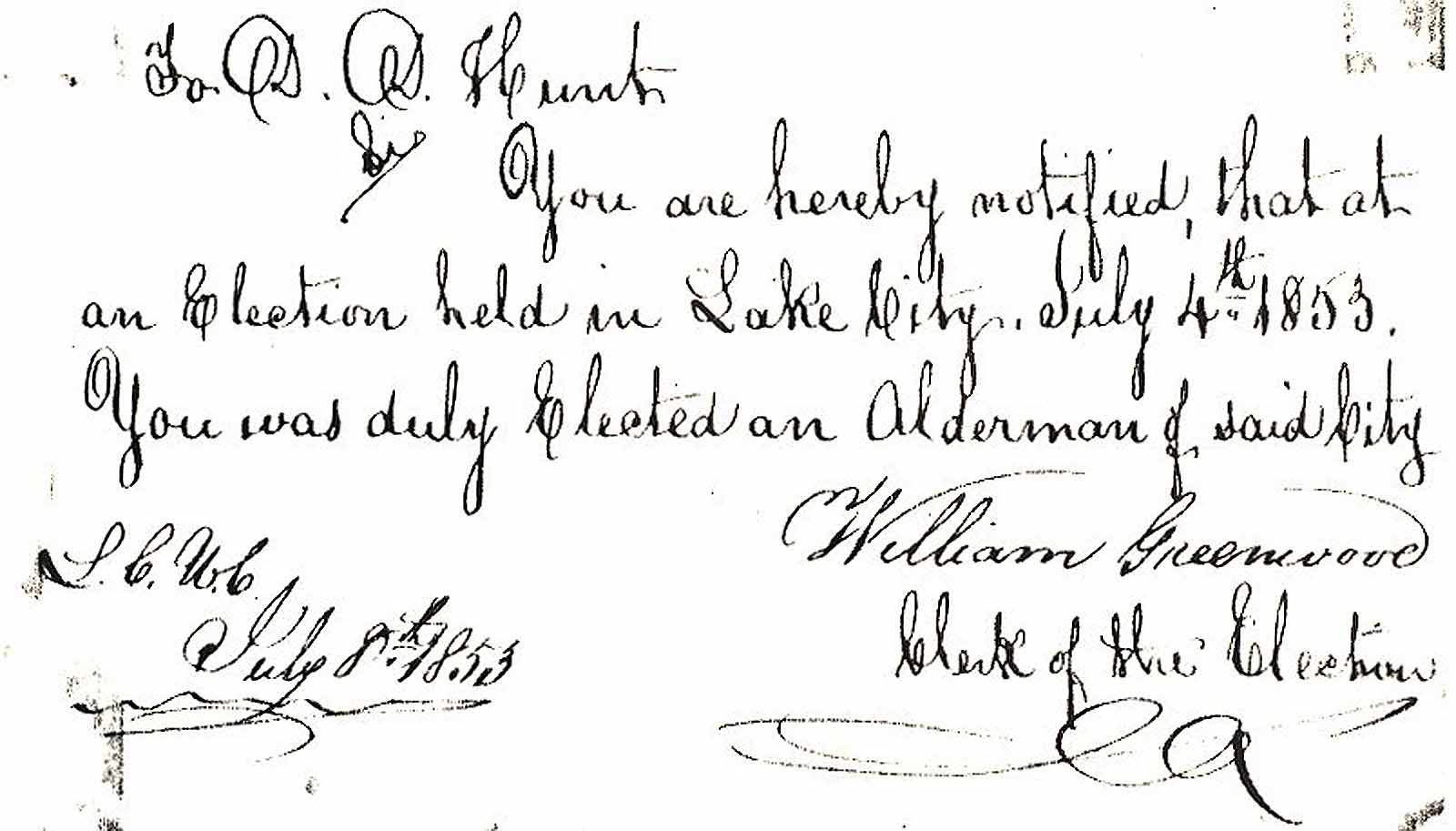 Great-grandfather Daniel D. Hunt was hereby notified that he had been elected
an Alderman in Lake City, July 4th 1853. Note that he was officially notified
on July 8th. Lace City was on or near the site of present American Fork.
Great-grandfather Daniel D. Hunt was hereby notified that he had been elected
an Alderman in Lake City, July 4th 1853. Note that he was officially notified
on July 8th. Lace City was on or near the site of present American Fork.
It seems that it was farming which attracted the Hunt family to Lake City, although we have to await another year and a half to verify the fact that he had negotiated for and eventually secured an eighty acre farm which, apparently, had been cleared of all encumbrances or indebtedness, according to the original document which is shown later. The document shows no legal description of the farm, and in fact, may contain the full history of the farm, since one, William Kelly, may have originally filed claim to it. The tope portion of the document, dated February the 7th 1853, reads, "I here sine (sign) over my right and clame (claim) of this farm to Barrel Covington - on the merrican (American) fork." Signed by William Kelly.
As is very obvious, at the bottom of the statement, a second transaction takes place, this time from Berrill Covington to a new owner, Daniel D. Hunt.
"This may certify that I assign all claim to 80 acres of land in Seminole Survey at merican Fork this the Dec. 12th 1854 To Daniel D. Hunt,
Witness: Berrill Covington Wm Greenwood
It doesn't seem unlikely that Daniel D. and family may have lived on this farm from their arrival in Lake City. Can we suspect that when Mr. Covington wrote, "I assign all claim", that there would remain no mortgage whatever against the farm? No attempt has been made to locate the whereabouts of the farm. Some day, perhaps, county land records will reveal to us where the farm was.
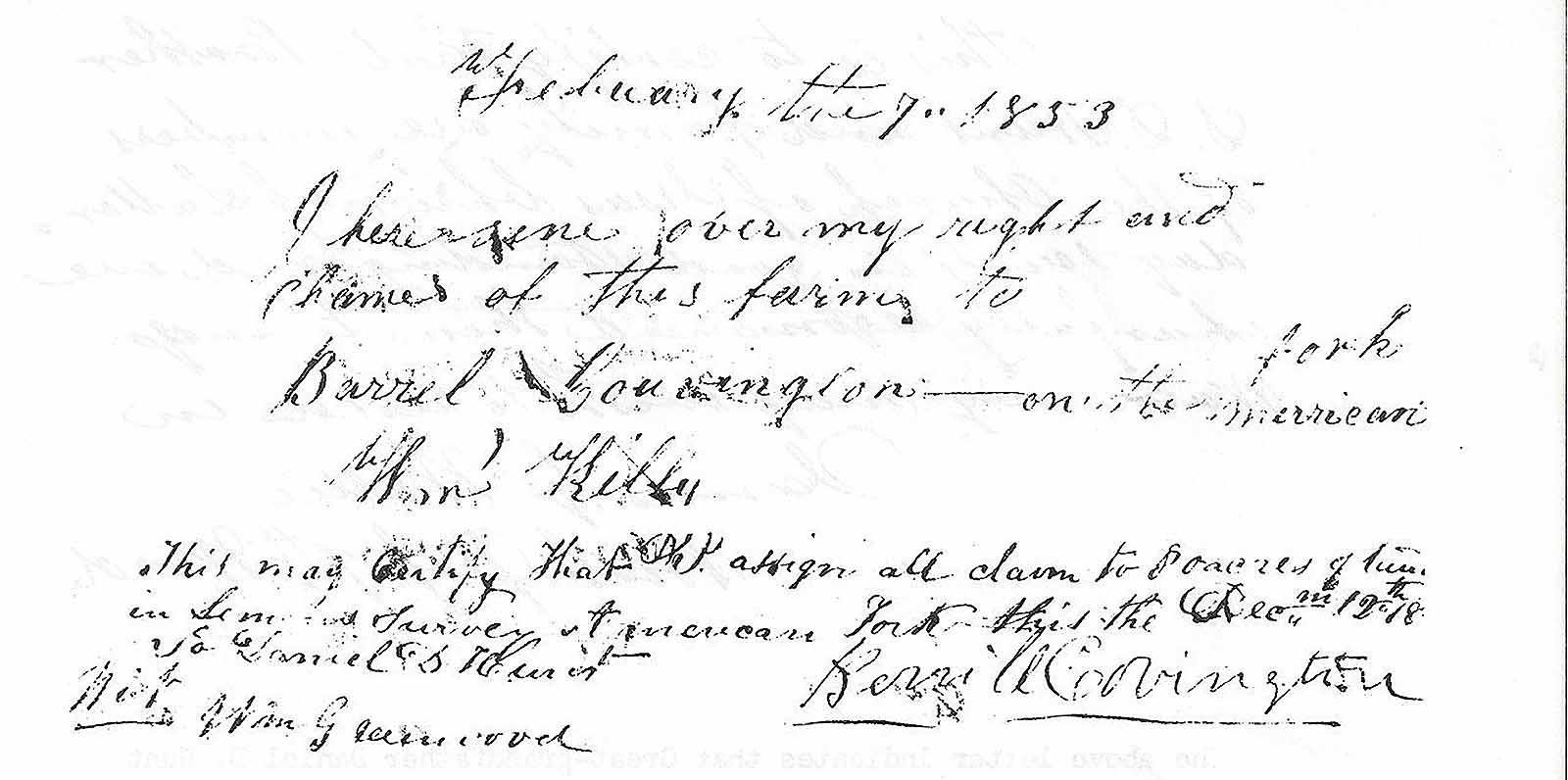 Legal document showing transfer of property on two occasions. Bottom note certifies
that on December 12th 1854, Berrill Covington transferred all rights to 80
acres at American Fork, Utah to Great-grandfather Daniel D. Hunt.
Legal document showing transfer of property on two occasions. Bottom note certifies
that on December 12th 1854, Berrill Covington transferred all rights to 80
acres at American Fork, Utah to Great-grandfather Daniel D. Hunt.
The early American Fork ward clerk gave considerable attention to off-time detailed reports of events which transpired in the ward. The earliest record we find of Daniel D. Hunt in that ward, was dated 15 October 1854, and was among the contributions of farm produce to the ward. His donation was two bushels of wheat. Of the several donations listed, few were larger than his.
As stated earlier in this history, Daniel D. Hunt was president of the Fifth Quorum of Seventy, which extended its membership from Salt Lake City to Lake City in Utah County, and as far west as Carson City, Nevada, as is evidenced by a letter from the Seventies there, written to their President, Daniel D. Hunt.
At this relatively early date in the history of Lake City, it appears all meetings of the Church as well as community events were being held in the schoolhouse. At a meeting of November 5th 1854, the ward clerk reports, "On motion of Pres. D. D. Hunt, the name of L.G. Harrington as bishop of this ward." The motion was unanimously approved. Also, in those same minutes, "---that John Mercer, J. Bovine and D. D. Hunt as school committee", whatever that meant, but probably, the local school board. These men were approved.
At a meeting on January 14th, 1855 at 7 p.m. in the schoolhouse, charges were made against some of the brethren for having poor fences "and their cattle were eating tithing hay. On motion of D. D. Hunt to refer the case to another time as the Bishop was not present."
The prominence of Daniel D. Hunt is very noticeable in the minutes of those various meetings.
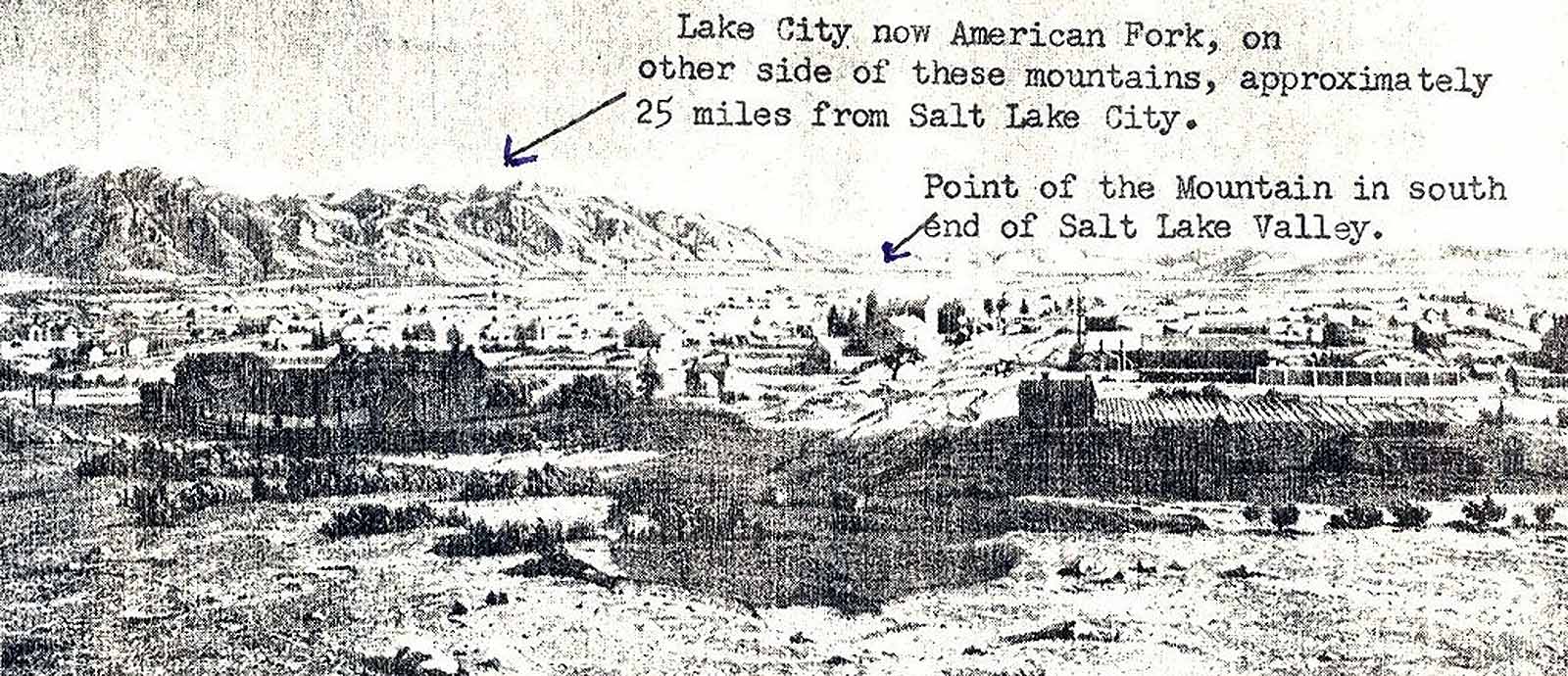 Great Salt Lake in 1853
Great Salt Lake in 1853
From Salt Lake City, as it appeared the very year Daniel D. Hunt and his family moved to Lake City, they traveled by wagon, probably with all their earthly possessions, to the south about twenty miles, until they reached the "Point of the Mountain" as we know it today. They went around the point and turned into Utah Valley and the western shore of the clear waters of Utah Lake. Present Day American Fork is the site of the Lake City of the 1850s where the Hunt family made their home for approximately three years. During these years, their two sons, John A. and James W., were separately called on their missions which will subsequently bring comment.
The picture of the schoolhouse below shows a Salt Lake Valley school, which was erected seven years following the Hunt's moving to their Lake City farm. While it was not in this school the Hunt children attended, their modest schoolhouse most likely would not have been so adequate, but theirs would have been typical. Certainly no more modern.
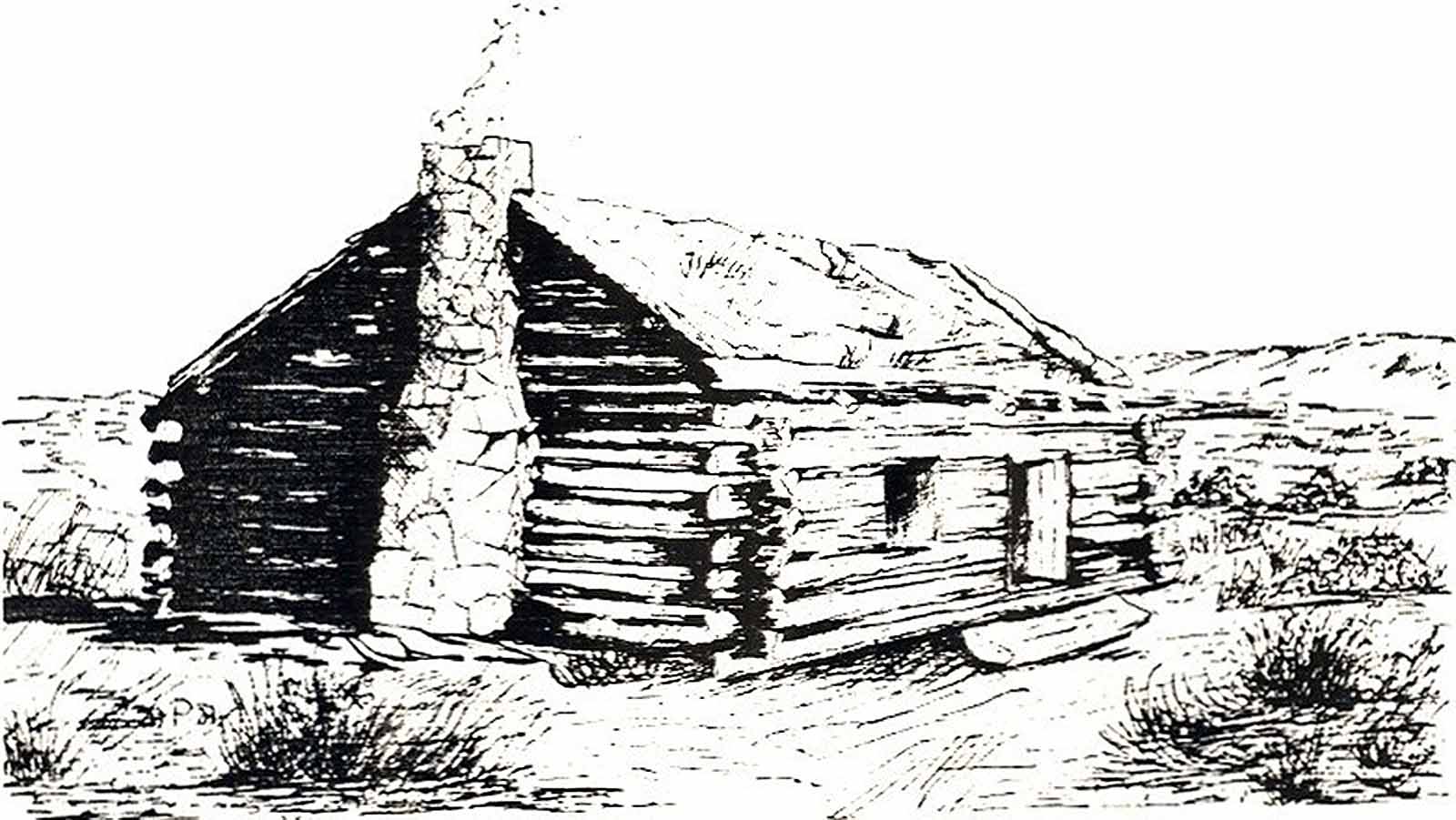
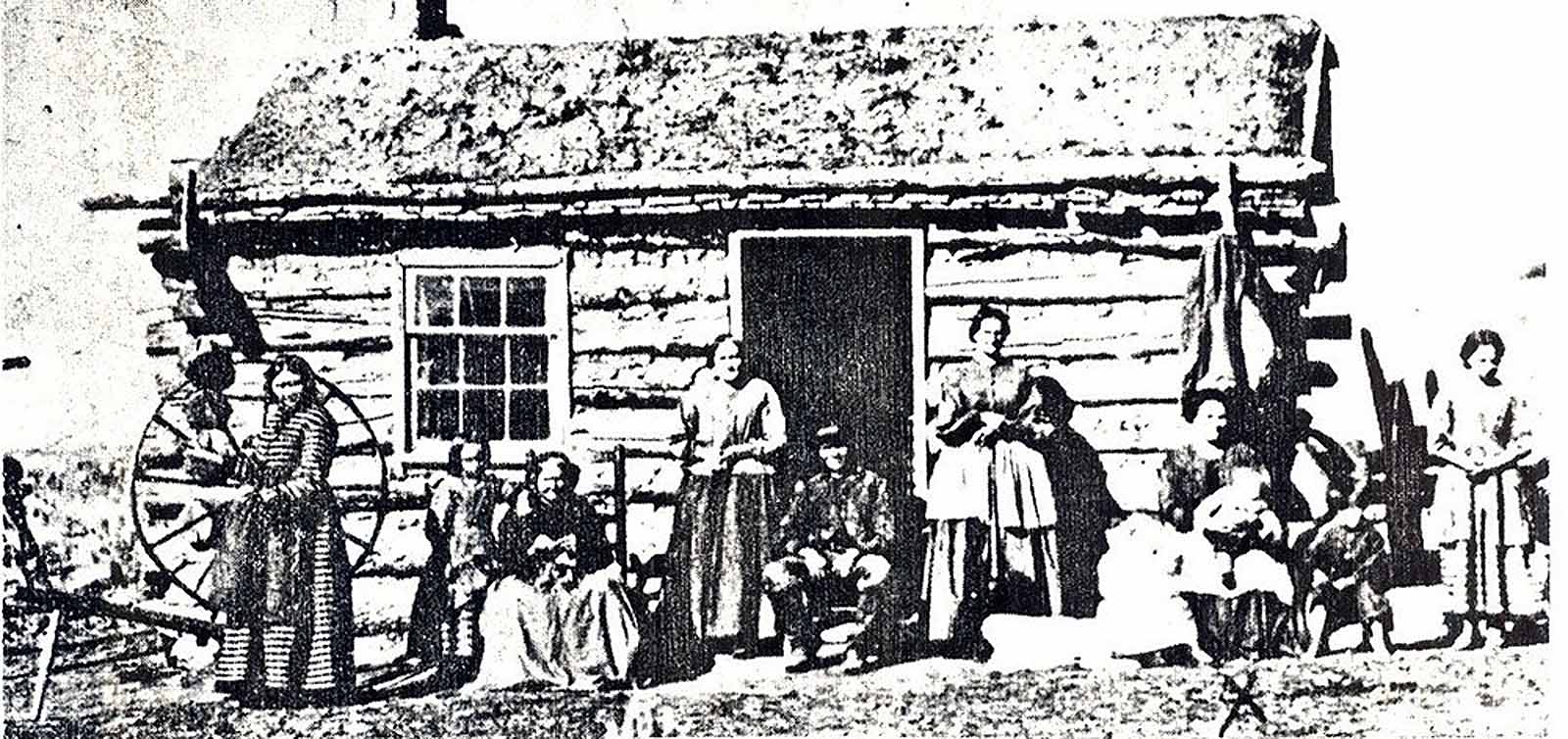 Layton Schoolhouse 1860 - First public building in Layton. Erected of logs
with a fireplace in one end; 16 x 16 ft. with thatched and clay roof. Benches
were pine slabs with small saplings for legs, and the floor was mother earth.
Layton Schoolhouse 1860 - First public building in Layton. Erected of logs
with a fireplace in one end; 16 x 16 ft. with thatched and clay roof. Benches
were pine slabs with small saplings for legs, and the floor was mother earth.
While the families and houses, nor team and wagon pictured on this page are not Daniel D. Hunt's, nevertheless, they typify what could have been his on his Lake City farm home in 1853, where the family moved after having resided in Salt Lake City for the two previous years. Logs cut from the nearby canyons were the quickest obtained materials for a shelter for the family. Dirt roofs, and for awhile, dirt floors were often resorted to. Farms came only after much hard manual work clearing sagebrush, and making ditches to carry the water from the canyon streams. This often became a community project, until the water reached the farm boundary line at which point, the family channeled it to the arid acres where the crops were to be planted. No crops without water. Note the water-barrel in which drinking water was hauled to the home from elsewhere, as it is carried on the near-side of the wagon below.
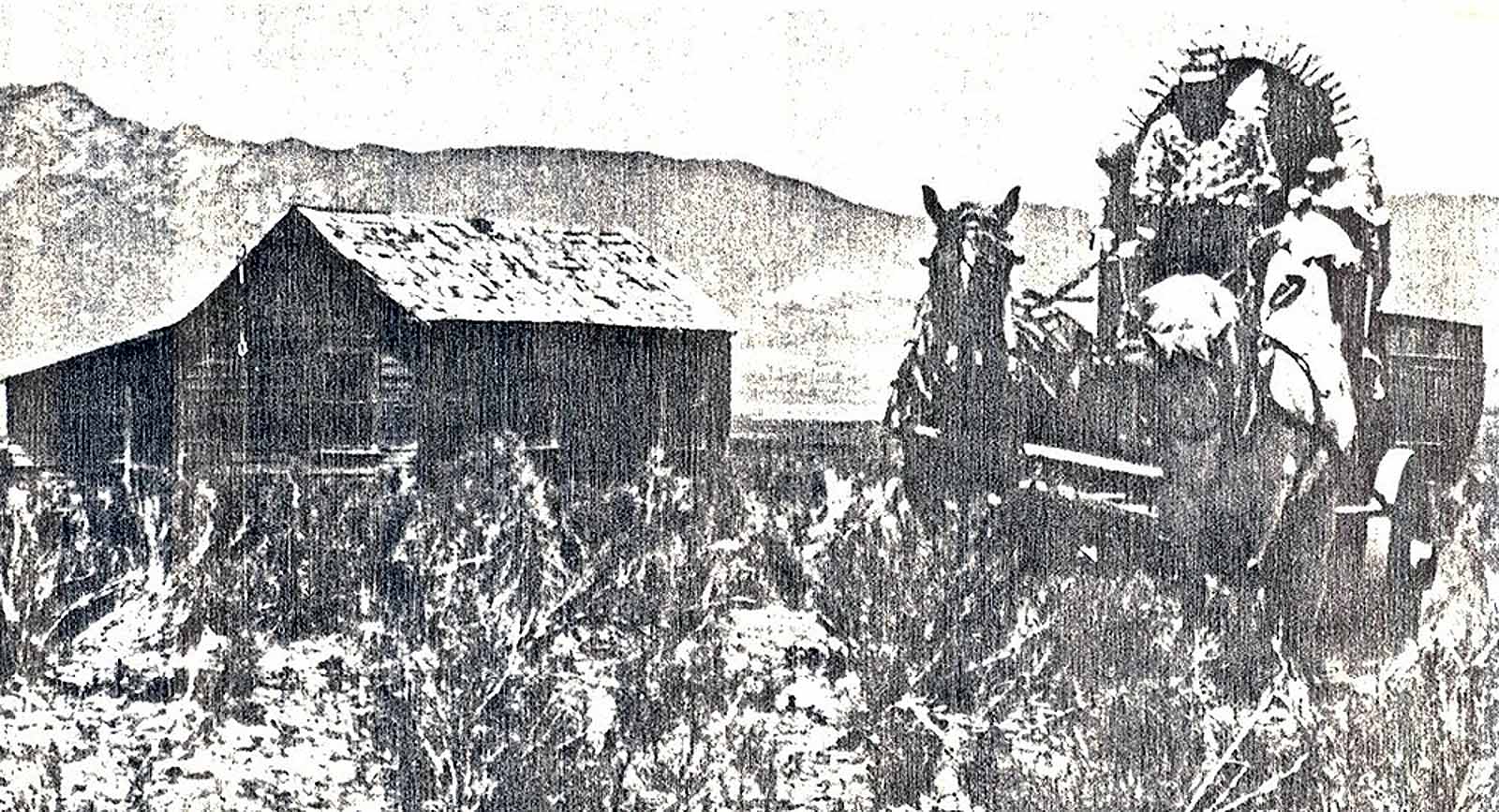
During these years of the 1850s it appears the president of the Seventy Quorum, had the authority to dis-fellowship, probably even to excommunicate, their own members from the Church. One of the cases mentioned in the minutes of the Lake City Ward, had to do with two Seventies who were critical toward the Authorities of the Church. They refused to do their part in constructing the local fort wall, as well as declining to send teams back on the road to assist the immigration movement coming West.
The two Seventies just mentioned, had been officially disfellowshipped on the 17th of September of 1854. Naturally, those affected were not happy with the move, and by the 28th of January 1955, the ward authorities called a special meeting of all the members of the ward to review the case. One of the two said he considered the course the Seventies took as illegal, and defied any man or woman to bring up "that I ever transgressed any law of this Church. I objected to pay my wall tax on the ground of its being illegal and when I get time I intend to prefer a charge against Daniel D. Hunt for illegally disfellowshipping me from the Seventies."
The other former Seventy, referred to the resolution which had been prepared for voting upon by the members attending the meeting following the hearing, which would indicate the ward's approval of the action taken by the presidency of the Quorum. He said that the very appearance of the resolution was like the Spanish Inquisition. He admitted that charges might be brought against him for bad conduct, however. He did not consider he was as good as he ought to be and reported he had stayed away from meetings on account of the Seventies organization, and confessed he did wrong in so doing.
Following their pleas for a reconsideration on the part of the Church officials, the Bishop said the latter's confession does not "hit the mark and his throwing out hints that the Seventies Council was a nest of scoundrels and comparing it to the Spanish Inquisition, was not in good taste on his part.
The resolution approving the action of the Seventies was presented to the meeting, and it was unanimously approved that the Seventies Council was justified in their actions.
The ward minutes of February 18th 1855, showed that Brother Daniel D. Hunt's child, Gashum Alma, was blessed by his father, the baby having been born on the 13th of January 1855.
As was customary to do, at the April General Conference of the Church, Brigham Young read from the pulpit the names of newly-called prospective missionaries, who were called to serve for usually two to three years. This he did in 1852, and among the names read was the name of John Alexander Hunt, son of Daniel D. Hunt. The Hunts were then living in Salt Lake City, and Great Britain was the assigned mission. Family history tells us, and it is confirmed in the Biographical History of the Church, Vol. 3, page 121, that John A., age twenty-two and his companion started their trip without purse nor script. He had come with his father to Sale Lake City in 1850, and two years later, he again crossed the plains, this time going east; It is reported that when he and his companion reached Philadelphia, the two of them had only eleven cents between them. Details are not known, but the Encyclopedia says, "but through the providence of the Lord they obtained means to continue the journey to Europe where Brother Hunt filled a splendid mission".
Later this history will refer to John A.'s return trip, however, back to Lake City, Daniel D.'s next son, James W. Hunt, was called by President Young at the April General Conference of 1855 to serve a mission. His special call was to be of shorter duration, and was to be to the Elk Mountain Mission in the south-eastern part of the state of Utah. The special purpose of this mission was to establish a fort and prepare the area for colonization. To make peace with the Indians was essential prior to the moving of families into the area.
The specific locality James W. Hunt and his forty companions were assigned to, was a little valley on the Grand River, where the settlement of Moab is now located. Forty-one men were called on this mission, with Elder Alfred N. Billings having been appointed the president. The company left Manti in Sanpete County, Monday, May 21, 1855. James W. Hunt was then twenty-two years of age.
The company took with them fifteen wagons, sixty-five oxen, sixteen cows, thirteen horses, two bulls, one calf, two pigs, four dogs, and twelve chickens, besides implements, seed grain, etc, beside their provisions. After a hard journey, they arrived on Grand River on the evening of June 11th. On the 12th, they crossed the river and came to some land that was cultivated by Indians, who were friendly and wanted the white people to settle among them. By July, they had built a stockade corral of logs, set three feet into the ground, and six feet above, and had put in their grain, etc. and started work on a stone fort. The fort was finished July 19th.
This writer has in his possession, the first and possibly only letter written by James W. to his father. The fact that it is now one month over one hundred-twenty eight years old, the writing has become dimmed, and is difficult to copy, but an attempt will be made to decipher it so far as is possible. It contains interesting information.
July 18th/55 Elk Mountain Mission Station
Father, dear sir, I sit down with pleasure and in the enjoyment of good health to address a few lines to you. It is also with pleasure and satisfaction that I perused your letter of the 6th which was delivered by C.----(not clear) and party on the 14th inst. We arrived here on the 10th of June. The distance is estimated at 405 miles from Salt Lake City. I have seen no part of the country yet that offered the slight inducement although this valley is the best that I have seen. A very small portion of this land is covered with good grass, the remainder is quick-sand not withstanding, we have put in from 30 to 50 acres of wheat corn, potatoes & ---(not clear) and are doing well.
On July 7th we laid the foundation of our fort which is 64 feet square & 12 feet high 4 feet and the base. The walls will be completed today.
When we arrived here an Indian was the scariest thing we had but now we are surrounded by them. Yes, they are friendly and show no disposition to steal or take that what does not belong to them and they are at all times more or less, during the day time in our camp. Some of them are beggars but as a general thing they are superior to those who are in the settlement begging for a living.
They own a great many horses and some of the first quality. Our fort which is built of stone is situated about one mile and 1/2 from Grand River near some small springs and a short distance from the mountain side. Grand river is about (?) rods wide and is fordable at this season of the year but when we came through we forded it and Green River. They are about 50 miles apart.
This valley is about 20 miles long and 3 miles wide. In short, the face of the country is rough, timber scarce and grass plenty only on large streams.
The Indian that was employed to carry the mail for the company came to the Green River and then got scared out at the high water and went back home.
Eight of our number are preparing to start for home tomorrow, a part of whom will return within about 1 month. Probably small companies of whom will keep coming in until all have a chance to come in this fall.
We have had no rain since we started of any consequence until today which runs through the wagon cover on my paper while writing. I must now close my letter. Write to me again. You can send it by the carrier of this letter. I would like to have a letter from the boys.
Yours Resp. J. W. Hunt
As the reader has already noted, the above letter was written by James on the 18th of July. In the interest of both time and space in this history, let it be said that this entire mission ended in disaster and was subsequently abandoned. From "Readings in LDS Church History" by Berrett and Burton, pages 383-385, the Elk Mountain Mission's coming to a close, will be copied,
"One of the settlers writes: Sunday, September 22nd we changed herd-grounds, feeling apprehensive of mischief intended by some Indians as they were very saucy and impudent. On inquiring why we changed herd-ground, the boys began loading their guns, which caused the Indians to cool down. The Indians went off a short distance to consult together. Soon three of them started for the field in the direction of the cattle and in a few minutes James W. Hunt started with a lariat to get on his horse. Charles, a son of Suit-Sub-Soc-Ots pr St. John, followed him on horse-back; He kept telling him to ahead of him, asking what he was afraid of, Hunt kept turning his head occasionally towards him, as though being apprehensive of danger, they got nearly a mile from the fort when Charles told him to look at the stock. He did so, raising himself on tip-toe. That instant Charles shot him, then shouted to another Indian, not far off, to run and take the horses. The ball entered Hunt's back, ranging downward about one and a half inches from the back bone, on the left side, and four inches from the small of his back. This happened about half past twelve 0'clock. Ephraim Wight and Sheldon B. Cutler were herding the stock. The Indians left and went across the river, Cutler came to the fort on horse-back and told what had happened. President billings jumped on behind him. Peter Stubbs followed, and while John Clark and another followed with water and returned to the fort, Clinton Williams started on horse-back after the stock. The boys carried Hunt in a blanket; but before they got within one fourth of a mile of the fort, the Indians re-crossed the river and came charging towards the boys and stock, raising a war whoop. Wm. M. Sterrett, Sheldon B. Cutler and Clark Hunnington acted as rear guard to the boys who were carrying Hunt and fired upon the Indians who had fired some eight or ten guns before our boys commenced shooting. President billings was wounded by a ball passing through the fore finger of his right hand. The bullets whistled briskly all around. The men arrived safely with the wounded man and the horses and cattle were taken inside the corral, except those the Indians had driven off. Every man was engaged. Soon one of the Indians set fire to our hay stacks which were adjoining the north end of the corral; they were entirely consumed, as also the corn, and it took five or six men steady to carry water to save the corral logs, so as to keep what stock we had on the inside. The firing was kept up by the Indians until after dark. We succeeded in saving the corral, although some of the logs were nearly consumed. Seven Indians were seen to leave. Charles at their head, going to the mountains. The day previous (Saturday) two of the boys, Edward Edwards and William Behunin went hunting, expecting to return Sunday afternoon. Captain Capsium, a Tampa Ute, came down to the corner of the fort and corral and talked to Clark A. Huntington for some time when a few more Indians came. They said we had killed two or three of them and wounded as many, and they would not be satisfied till they had killed two more "Mormons". They at first denied having killed the boys who were out hunting and wanted bread. We gave them all we had. The Indians had turned the water off from us. They finally acknowledged killing the two boys out hunting. Hunt expired the following day.
"Early in the morning of Monday, Sept. 24th, the Indians came to the fort and said they were glad that three Mormons had been killed; they had killed the two boys as they were coming down the mountain. Thus three of our boys were killed. Three Indians had also been killed and three others wounded who would die. It was thought best to move out right away, or we should all die, as the Indians had sent runners out into the mountains for help. We packed up and without breakfast left about eleven o'clock in the morning, leaving fifteen head of horses, twenty-four head of cattle with a calf, besides six head which we gave the Indians. When we got to the north side of Grand River, a brother of St. John and uncle to Charles, the leader, came to us. Clark A. Huntington told him all that had taken place, and what we had left behind. He said it was too bad, but he was only one against many. He said we should have our cattle, and he would see that the bodies of the boys who had been killed were taken care of and buried. Together with his sons he went to the fort and talked to the Indians. He had some difficulty with them, when they began shooting the cattle. The friendly Indians who succeeded in driving away fifteen head of cattle, delivered to us eight cows and kept seven that were wounded. They butchered three head and brought us a little of the meat.
"We arrived in Manti, Sunday, Sept. 30th, between 4 and 5 o'clock p.m. John McEwan who was left behind the last morning driving his pony which was tired, some three miles from where we started, got bewildered and lost his way. The trail being dim and not very easy to follow, left all he had except his gun and traveled eating nothing from Saturday night the 27 till Wednesday forenoon the 3rd of October about eleven o'clock a.m. when he was met by three men, viz.; Nathaniel Beach, John Lowry, Jr. both of Manti and Lyman Al Woods of Provo, and two Indians belonging to Arrapeen's band who left Manti on Tuesday night at half past ten o'clock in pursuit of them. They arrived at Manti Thursday morning 7:30 o'clock."
The two co-authors of the above credited history, Berrett and Burton, gave credit to one Peter Gottfredson, "Indian Depredations", pp. 84-89 for the above account.
The above story leaves a concern. Were the bodies of the three young men left to be buried by the friendly Indians who were apparently very much in the minority of their fellows? An apparent discrepancy shows up in the story. It commences, "Sunday, September 22nd - Hunt expired the following day". His death date is recorded by the family as September 23rd which agrees with the above story, however, the above account reads, "early in the morning of Monday, Sept. 24th ---"Actually, if there is an error in the dates letit be but if James W. was shot on Sunday and died the next day, Monday. It would have occurred the very day they broke up camp, then it may be understandable why, in desperation to save their own lives, they left the bodies unburied. Were there three days involved - the 22nd, 23rd, and 24th - then it would seem time could have been found for a quick burial, even if done during the night of the 23rd, or very early morning of the 24th. It is not like pioneer tradition to have so little regard for the body of a comrade. Some questions may never be answered.
Of late years - possible in the 1960s - this writer remembers well a short article in one of the Church periodicals, which was a report by the organization, Daughters of the Utah Pioneers, that a pioneer marker had been sets up by the Moab Camp of that organization. A picture of the marker was shown in the periodical as well as a copy of its message, which is here given. Regrettably, the source has not been located:
"In April, 1855, forty-one men under the leadership of Alfred N. Billings were called to establish a mission in the Elk Mountains. They left Salt Lake City May 7, 1855, arriving at Grand River June 11, and selected the site for a fort. By July 15, they had built a fort 64 feet square, with stone walls, 12 feet high, 4 feet at the base and 11/2 feet at the top. Three of the pioneers, James W. Hunt, Edward Edwards and William Behunin, were buried within the fort which was located about 800 feet from this monument." (Moab Camp of the Daughters of the Utah Pioneers)
Among the few excerpts of a historical nature left by Daniel D. Hunt is the following:
"James Wiseman Hunt was born 2 November in the year 1832 and was baptized into the Church of Jesus Christ in 1843 by George Brannon and was ordained a seventy under the hands of his father and J.W. Colley (probably meant to be J. W. Cooley. L.B.) in the year 1849 and was a faithful son to what he was called on to do and was called on a mission in May 1855 to the Elk Mountain Indians and was killed by one of the chief's sons, on the 23rd of September. Fell a martyr for the cause of Jesus Christ and his innocent blood was spilt with two others for the cause of Truth."
From the schedule of the returning party arriving back in Manti on September 30th, the message of the death of his son, James W., probably would not have reached Daniel D. until the first day or two of October of 1855. This would have been a sad day, indeed, for the Hunt family. As stated earlier, this mission was for a short term, and it was to have been concluded prior to the end of the year if all went well with them.
Returning again to the minutes of the Lake City ward. The clerk was quite observing and wrote the following, relative to the year 1855: "This year 1855 has been a year long to be remembered for the God of Israel truly has shown to the Saints in this place that he can send the plagues to cut off vegetation both for man and beast. The grasshopper was almost as numerous as the sands on the seashore, sweeping and destroying before them all the labor of the husbandman. Yet with much toil and replanting the Almighty blessed and gave us a harvest that we have been preserved alive."
What a year 1955 must have been for the Daniel D. Hunt family!
The minutes of 24th September 1855 - (this prior to the word of James W. reaching Lake City) - and having to do with contributions: "The following subscribed potatoes for Pres. Joseph Young: D. D. Hunt, 1 bushel." Sixteen others were included, some giving as much as a bushel, but about half donating a half bushel each.
We gather enough from the minutes that Daniel D. must have received a special assignment from his superiors, the General Authorities. Not enough is given for us to learn the details, but the minutes read : "Oct. 21, 1855, 11 a.m. - Elder Daniel Hunt preached his first discourse on his appointed mission in the Callup on 'the principle of a starting point'" The reader will be left to draw his own conclusion.
Included with an interesting set of minutes dated February 11th 1856, at 6 p.m. meeting at the school, was a statement that a group of young men became involved in a skirmish among themselves, which resulted in a little fisticuff action and bruised faces. The names of several young men were given and among them were sons of Daniel D. Hunt: Benoni, Levi and Daniel Jr. Only a few of the boys appeared to have participated, but Benoni was named as the dominant participant. Even among the Hunt family, it appears boys will be boys.
The above is the last set of minutes in which the Hunt family names appear in the Lake City ward - February 11th 1856 - and we wonder. Later evidence reveals that they moved due to the severe year of 1855, which was mentioned earlier. We gathered from an earlier land transaction that they were, at the time, free of debt so far as the eighty-acre farm was concerned. Under these conditions, it seemed they would have been able to have made a go of it, despite crop failures, or could their leaving be the result of a possible emotional trauma by their losing their missionary son, James W.? These things we don't know. Also, it is well for us to remember that by the last date we have just mentioned, their oldest son, John A., would be in the closing months of his mission to England. Later we shall hear of him again, but in the mean time, another chapter in the life's story of Daniel D. - a most interesting man.
On the back page of the Church News for several years has been and still to this date - -March 1984 - - has appeared weekly a series of articles entitled "Missionary Experiences
As indicated above the accompanying article appeared on the 16th of February 1974 telling of the tragedy which occurred to James W. Hunt, son of Daniel D. Hunt.
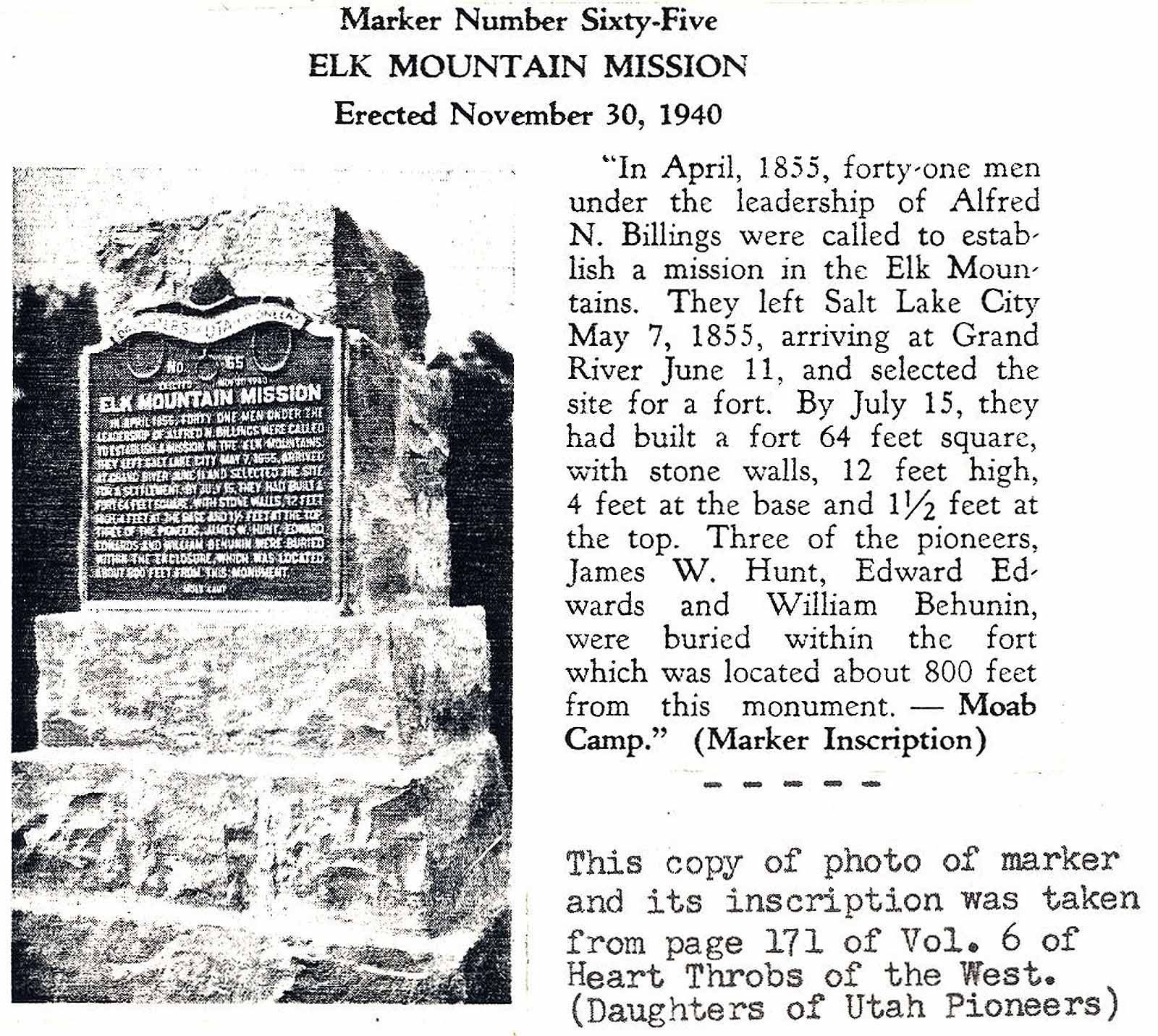
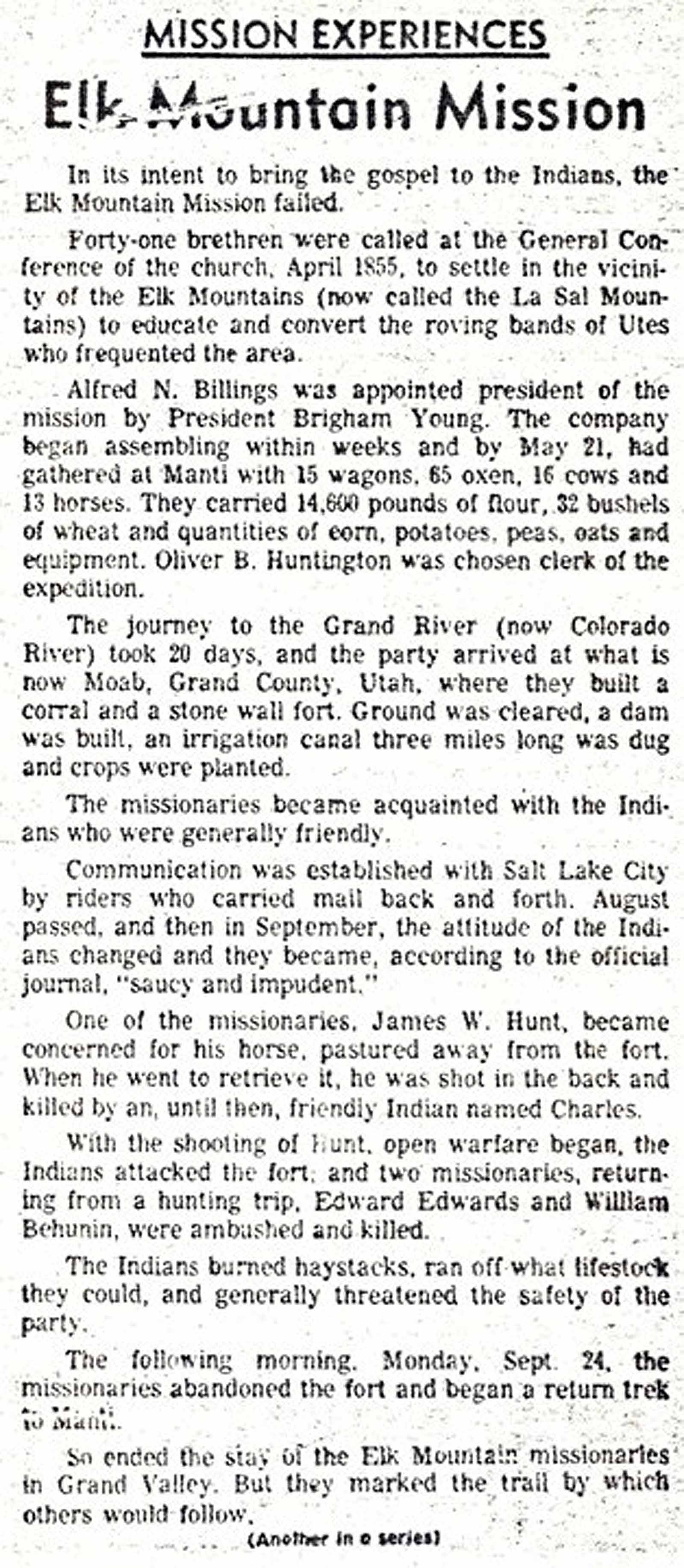 On the back of the CHURCH NEWS for several years has been and still to this
date - March 1984 - has appeared weekly a series of articles entitled "Missionary
Moments"
On the back of the CHURCH NEWS for several years has been and still to this
date - March 1984 - has appeared weekly a series of articles entitled "Missionary
Moments"
 As indicated above the accompanying article appeared on the 16th of February
1974 telling of the tragedy which occurred to James W. Hunt, son of Daniel
D. Hunt.
As indicated above the accompanying article appeared on the 16th of February
1974 telling of the tragedy which occurred to James W. Hunt, son of Daniel
D. Hunt.